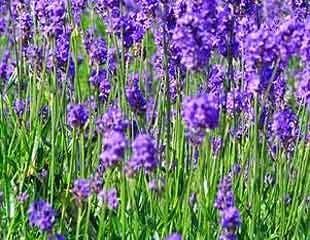
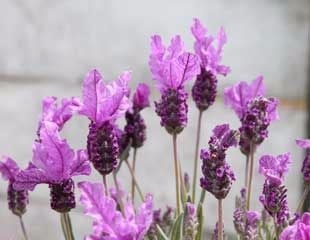
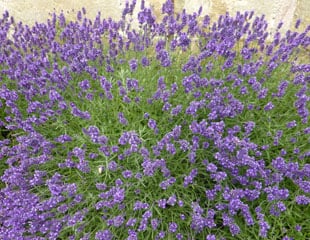
How to grow Lavender
Lavender is a woody, small to medium-sized perennial shrub.
Evocative of an English summer, lavender flowers in shades of blue, lavender, white and pink. It is aromatic and very attractive to bees.
When growing Lavender, the key to success is the right planting conditions. To do well, lavender needs sun and well-drained soil. Lavender grows badly in wet soil, especially winter wet.
Often considered a quintessentially English plant, Lavender is part of the genus Lavandula with about 25 species, which originates from the Mediterranean and warm climates.
Where To Plant Lavender
Soil conditions
Given its Mediterranean origins, Lavender needs good drainage and a sunny spot, both are essential. Because Lavenders do well in dry spots, they are drought-resistant, ideal for Mediterranean planting schemes, and gravel gardens.
In addition, Lavender is ideal for growing in containers, provided there is sun. If your ground growing conditions are not ideal, the advice below for growing lavender in wet conditions.
How To Plant Lavender
Before planting, water the lavender plant well and or soak it in a tub of water for 30 minutes+
To plant the Lavender, dig a hole about 5 cm bigger than the pot the plant came in. Tease out the roots. This means using your hands to loosen the roots. Plant at the same level so that the soil from the potted plant is at the same level as your garden soil.
If you are planting several lavender plants, check the labels for plant size and space them out appropriately. Lavender varies in size from 05.x.05 to 1mx1.5m, which makes spacing critical.
Water well and firm it in so it's secure with no air pockets. All shrubs, even drought-resistant ones like lavender, need watering for the first few months to get established.
Growing Lavender in Wet conditions
Problems growing Lavender in wet soil
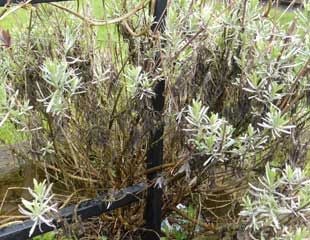
Lavender hates wet conditions, especially over winter. If your garden is wet, there are things you can do to grow Lavender successfully.
You can add horticultural grit (sold at garden centres). If your ground is heavy or becomes waterlogged in winter, you can ameliorate this by adding horticultural grit. You can achieve this by creating a larger planting hole and adding grit around the perimeter. Alternatively, you can dig a gravel trench to create a greater area of free-draining soil. There is no guarantee of success. Gardeners in the South and East, with drier gardens and free-draining soil, will be wondering what on earth I am on about, recommending all these trenches and grit. But having grown lavender in a Pennine garden and a garden in the east of England, there is a huge difference in growing conditions.
If poor growing conditions prevail, you may be more successful growing lavender in containers, which are always drier, and you can fill them with suitable free-draining compost. If you want lavender as part of the garden border, you can always sink the containers into the border.
An excellent alternative to Lavender, which will grow anywhere and is very tough, is Nepeta. It features clouds of soft blue flowers, much loved by bees, and blooms all summer long.
Above is an image of lavender growing in one of my wetter Pennine gardens. The soil was very wet, and by the end of the Winter, it was fit only for the compost heap.
For wet soil, you can grow Nepeta, plant Lavender in containers or take a look at lavenders designed for wetter gardens.
Best lavender for wetter gardens
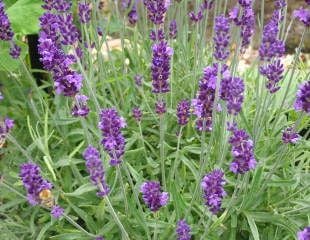
There are some varieties of Lavender said to be more tolerant of wetter conditions. Breeders developed Lavender 'Havana' for wetter growing conditions.
I planted it in a wet Pennine garden close to the water table
It did emerge from the winter wet in better shape, so worth a try, and a nice-looking lavender. I found this to be one of the best Lavenders for wet soil.
Available from Suttons are Lavender 'Havana' and a good selection of lavenders.
How to Grow Lavender in containers

Lavender is ideal for growing in containers because it prefers drier, free-draining soil and is drought-tolerant.
It is essential to place the container in a sunny spot to ensure lavender gets the benefit of full sun.
As for pot size, it is tempting to put the lavender in a large pot, thinking it will grow into all the space. Plants can fail to thrive if you plant them in an oversized pot. It is better to pot up in stages into a slightly larger pot, then a slightly larger one, and finally, into the eventual large pot.
When a plant is in a container that is too large, over-potting happens. While the plant may sometimes adapt, conditions such as overly wet compost, excessive rainfall, or unfavourable weather often hinder growth. In these circumstances, poor aeration around the roots reduces nutrient uptake, resulting in slow growth and poor performance.
Pot up in two/three stages and keep lavender on the dry side in a sunny spot.
Lavender stoechas The French lavender

This is Lavandula stoecha, also known as French Lavender and as fathead lavender.
It requires similar growing conditions to the English lavender, but can be trickier. Lavender stoecha is more difficult to grow in less-than-ideal conditions, and more tender.
Think of L. stoecha as the English lavender's more sensitive cousin. In perfect conditions, it will grow well in the UK. Those perfect conditions are sunny, well-drained soil which does not retain water, sheltered and not prone to frost, snow or cold winters. The more your garden differs from the perfect conditions, the less cooperative it becomes. A struggle.
Various sources describe Lavender stoecha as both H3 and H4 hardy, but ideal growing conditions determine those ratings.
Improve growing conditions by growing in containers, which will certainly make the growing medium drier. However, in areas of higher rainfall, it will suffer and also, if there is less sun; container growing cannot overcome all obstacles.
Typically, it grows to around 60 x 60cms and is similar to English lavender. Prune lightly after flowering, or in March before the new growth.
Is Lavender low maintanance?
Lavender needs little care. It does not need feeding or frost protection. Prune lightly in late summer, cutting off the spent flowers and creating a good shape for next year.
Lavender is drought-resistant and, once established, will not need watering. It grows easily from cuttings, and even if you give it no attention at all it will flower year after year.
How to Prune Lavender
Grown in the right conditions, lavender requires very little pruning. Standard advice is to lightly trim lavender after flowering but there is a little more to consider- timing is important, and also the type of garden you are creating.
For step by step guide to pruning lavender, how and when to prune and images, check out How to Prune Lavender.
Is Lavender Frost Hardy?
Hardiness ratings for the most commonly grown Lavenders:-
1. Lavandula Angustifolia, known as English Lavender, shown in the above images left and right L. ( and below) varieties such as Hidcote and Munstead are H5, which is down to-10-20. Within this group are varieties in shades of blue, lavender, pink and white, and many sizes.
2. Lavendula x intermedia group of Lavenders, also known as English Lavender. This group is hardy in most UK winters, H5 and tend to be larger than L. Angustifolia ideal for hedging.
3. Stoechas, known as French lavender and fat head lavender, is described as H4 -5-10 but in reality is more borderline and may need winter protection, illustrated above centre.
English Lavenders are all described as H5 hardy (explanation about hardy plants) and the French lavender is also described as H5, but it is much more border line in areas of cold and wet winters.
Lavender plants are a short-lived perennial; up to 10 years in perfect conditions, but they often become leggy, woody and with bald spots after a few years in less than ideal conditions.
8 popular varieties of Lavender
Lavendula 'Hidcote'
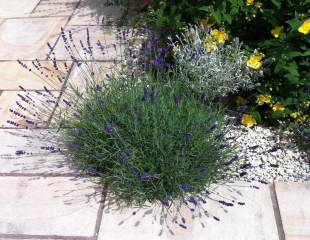
This is a newly planted Lavandula angustifolia 'Hidcote' it has one of the best colours and on the hardier side also illustrated above centre.
Lavendula ' Munstead'
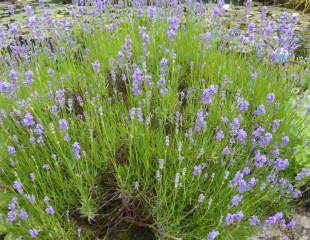
This is more mature Lavendula 'Munstead' similar to Hidcote is shape and size, also in terms of hardiness, although a pale colour.
Lavendula x intermedia
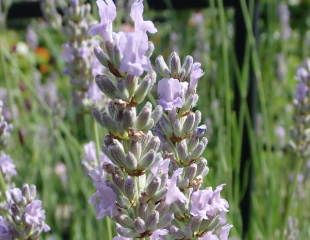
A tall variety of Lavender, with a lovely scent it has long stemmed pale mauve flowers. It has a loose formation and its height of up to 1m+ makes it ideal for hedging and paths.
Nepeta an alternative
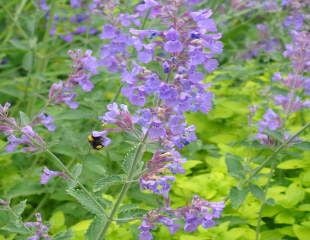
If conditions are not suitable for Lavender and you want soft blue spires of flower, Nepeta is a good standby. Very easy to grow and tolerant of everything, including being chewed by cats and loved by bees. If it gets too tall, Nepeta responds well to the Chelsea Chop.
Perovskia Russian sage
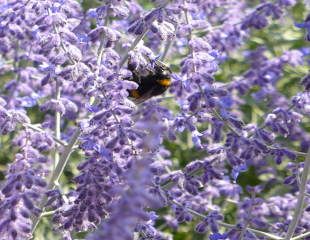
This is Perovskia ' Blue Spire', another great alternative to lavender. It has a more upright shape than Nepeta and is taller growing to around 1m with tall blue upright spikes of aromatic flowers which the bees go mad for.
Plant a Lavender path
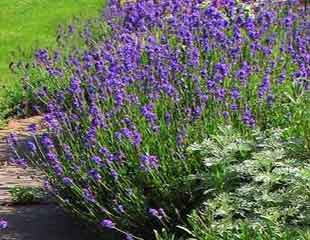
Planting lavender alongside a path makes a lovely scented walkway. As the passerby walks along, the lavender is brushed, which causes the scent to be released. Equally good is to plant the lavender in a low wall to release scent.
